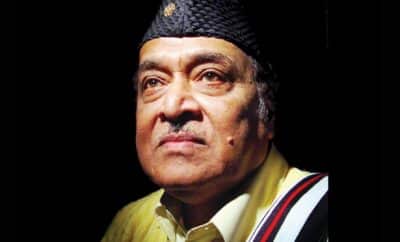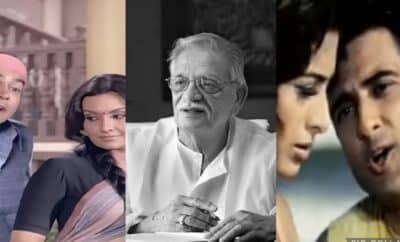Collections
C. Ramchandra – The Wizard’s Magic sans Lata Mangeshkar
Despite having little musical background, he had a flair for music right from his early years. Though music was always his first love, due to impressive looks and to earn a livelihood, he decided to try his luck in the films as an actor. After going through a lot of ups and downs – starting from an important role in his very first job in an eventually shelved film to a side actor – he finally got the role of a hero in a Marathi film Naganand. But the film was a flop at the box office, and he was again reduced to a side actor in Sohrab Modi’s “Minerva Movietone”.
He accidentally got into the music department of the production house as an assistant and the path of his career changed completely very soon. Towards the end of his stint with Minerva Movietone, he got introduced to the director-actor Bhagwan Dada (Palav), who got him the first opportunity as an independent composer for his Tamil directorial venture Jayakodi (1940). But success was still a distant dream. After a few more twists and turns, and another Tamil film, Vana Mohini (1941) as an independent composer, he got his first Hindi film Sukhee Jeevan (1942). The first Hindi song that he recorded for Sukhee Jeevan was Dr. Mohammed Iqbal’s famous patriotic song “Saare jahaan se achchha Hindostaan hamaara”. The then very famous composers Robin Chatterjee, Anil Biswas, and K. Dutta were present at the recording of this song, as they were inquisitive about this new composer. As this was a chorus song, they impromptu participated in the recording as chorus singers. Both, the film and its music, were hit and the Marathi youngster Ramchandra Chitalkar – Ram Chitalkar – C. Ramchandra finally embarked on his success spree.
The train of his success was running with full speed, and he happened to record his first song with Lata Mangeshkar – “Jawaani ki rail chali jaaye re” for Shehnai (1947). It was sung by Geeta Dutt and himself, alongside Lata Mangeshkar. He was thoroughly impressed with Lata Mangeshkar’s flawless rendition and talent. They developed an excellent rapport soon thereafter, and the rest is history.
His style was original. He composed in his unique style many toe-tapping numbers based on western music as well as many euphonious romantic and soulful numbers based on Indian classical music with equal proficiency. His music thus kept on appealing the fans of western music as well as the lovers of Indian melody.
No doubt, Lata Mangeshkar’s voice was the be-all and end-all of C. Ramchandra’s music almost for a decade. But was that all about his music? Certainly not! He has beautifully used almost all the famous singers in golden era in his songs.
While a lot has been written and talked about his joint work with Lata Mangeshkar (and a lot can still be written and talked), let us have a fleeting glance at his oeuvre minus Lata Mangeshkar.
1. Asha Bhosle – Ye Jee Chahta Hai (Amar Deep – 1958)
Asha Bhosle replaced Lata Mangeshkar as the primary singer for C. Ramchandra during the late 1950s, when Lata Mangeshkar started appearing less frequently in his songs due to their personal differences. Amar Deep was one such initial soundtrack in which Asha Bhosle appeared conspicuously – in 7 out of the 12 songs, whereas Lata sang only 2 solos. While the two Lata solos, “Mere man ka baawra panchhi” and “Dil ki duniya basa ke saanwariya”, are outstanding, the Asha – Rafi duet “Dekh hamen aawaaz na dena” is also par excellence. Asha has also sung a beautiful and sentimental solo for this film – “Ye jee chahta hai”, which is somewhat overshadowed by other popular songs. The tune, particularly the refrain, has some unique touches and Asha Bhosle has rendered them effectively together with the sentiment of the song. Rajinder Krishan is the lyricist.
2. Mohammed Rafi – Ye Hasrat Thee (Nausherwan-E-Adil – 1957)
While Mohammed Rafi was always seen in C. Ramchandra’s music, he has only a handful of notable solos under his baton. One of them is the soulful solo “Ye hasrat thi” from the costume drama Nausherwan-E-Adil. The two romantic Lata – Rafi duets from this soundtrack “Taaron ki zubaan par hai” and “Bhool jaayen saare ghum” are the high points of this album, but the pathos-laden Rafi solo also cannot be ignored. Rafi expresses the poignancy in this song as effectively as he expresses the sweetness of romance in the two duets. The lyrics are penned by Parvez Shamsi. We get to see a more freely moving and expressive Rajkumar in this song.
The film was produced by Sohrab Modi’s Minerva Movietone. Interestingly, C. Ramchandra was thrown out from the production house due to some differences circa 1940, when working with there as a salaried actor / music assistant. The same production house engaging him as a composer for its movie perhaps speaks volumes about the success and popularity that he had attained by then.
3. Talat Mahmood – Muhabbat Hi Na Jo Samjhe (Parchhain – 1952)
Talat Mahmood was one of C. Ramchandra’s favourite singers, and this is evident from several fantastic songs in which he has used his voice. One of their beautiful joint works is the Talat solo “Muhabbat hi na jo samjhe, wo zaalim pyaar kya jaane?” from the V. Shantaram’s romantic melodrama Parchhain. Talat Mahmood has taken this sitar dominated composition based on C. Ramchandra’s favourite raag Bageshri several notches up with his silken and emotive rendition. The song is written by Noor Lakhnavi and is filmed on V. Shantaram and Jayshree.
4. Mahendra Kapoor – Kaun Ho, Tum Kaun Ho? (Stree – 1960)
Mahendra Kapoor, who had made a debut as playback singer in 1953, couldn’t taste the success for a few years thereafter. When he had lost the faith in the film industry due to some bitter experiences and was about to give up, he happened to participate in the All India Murphy Metro Competition. The panel of judges had the stalwarts like C. Ramchandra, Naushad, Madan Mohan, Anil Biswas, and Vasant Desai. Mahendra Kapoor was declared the winner. It is said that some of the judges were not in favour of declaring him as the winner, but C. Ramchandra was instrumental in he being declared as the one by strongly supporting his case. Soon thereafter, C. Ramchandra signed him for V. Shantaram’s Navrang (1959). With the songs of the film, Mahendra Kapoor was noticed as a playback singer for the first time in real sense, so much so that many people still believe that Navrang was his debut.
Another V. Shantaram costume drama Stree, which was based on the celebrated Sanskrit play Abhijnaanashaakuntalam by Kalidasa, had a mellifluous soundtrack composed by C. Ramchandra. Mahendra Kapoor has sung a soft romantic solo “Kaun ho, tum kaun ho?”, which is written by Bharat Vyas. Just a glimpse of Shakuntala has hypnotised King Dushyanta and he is expressing his wonderment through the song. Befitting soft yet catchy orchestration comprising veena and violins and Mahendra Kapoor’s velvety rendition make this an adorable composition.
5. Hemant Kumar – Ae Baad-E-Saba Aahista Chal (Anarkali – 1953)
Though Hemant Kumar and C. Ramchandra were competitors, they respected each other a lot and always appreciated each other’s talent. What’s more, C. Ramchandra has used Hemant Kumar’s deep baritone voice in quite a few soulful compositions. Besides the unforgettable duet with Lata Mangeshkar – “Jaag dard-e-ishq jaag”, Hemant Kumar has also sung a solo for C. Ramchandra’s milestone soundtrack Anarkali – “Ae baad-e-saba aahista chal”. The song written by Rajinder Krishan plays in the background of title credits of the film and narrates Anarkali’s story concisely. As the story is being narrated by a senior person who has been witness to a lot, Hemant Kumar’s sage-like voice is the perfect choice.
6. Kishore Kumar – Chaand Chupchaap Hai (Daal Mein Kaala – 1964)
C. Ramchandra used Kishore Kumar’s voice selectively, mainly for the films in which he himself acted. The soundtrack composed by C. Ramchandra in his distinctive style for the comedy of errors Daal Mein Kaala featuring Kishore Kumar and Nimmi in the lead roles has an amorous Kishore solo “Chaand chupchaap hai, sitaaren gumsum” written by Bharat Vyas. Romantic tune with pleasing orchestration mainly comprising mandolin, violins, and flute announce end-to-end that this is C. Ramchandra melody. Needless to say, Kishore Kumar’s rendition does complete justice to the composition. Both, the movie and the soundtrack, are however forgotten unfortunately.
7. Manna Dey – Yahi Paighaam Hamaara (Paigham – 1959)
Manna Dey also appeared in C. Ramchandra’s repertoire only sporadically. This Manna Dey solo from Paigham written by Kavi Pradeep advocates a socialist and secular society. As the song passes on a serious and deep message, there could not have been a better choice than Manna Dey.
8. Mukesh – Jap Jap Jap Jap Jap Re (Sharada – 1957)
The Asha dominated soundtrack of Sharada featuring Raj Kapoor, Meena Kumari and Shyama in the lead roles has a Mukesh solo in which Raj Kapoor is seen wooing Meena Kumari in a comic way. The lyrics are written by Rajinder Krishan. The song is unique because it has a somewhat rare combination of C. Ramchandra and Mukesh and is also a comedy song, which is a rarity so far as Mukesh is concerned.
9. Geeta Dutt – Dil Ko Bachaana Raja (Shagufa – 1953)
Geeta Dutt seems to have hardly found place in C. Ramchandra’s camp after the 1940s. Even during the 1940s, she appeared mainly in duets or group songs. Here is a peppy solo written by Rajinder Krishan that she has rendered under C. Ramchandra’s baton for Shagufa.
10. Suman Kalyanpur – Saanwariya Re, Apni Meera Ko Bhool Na Jaana (Aanchal – 1960)
Suman Kalyanpur was also rarely seen in C. Ramchandra’s music. One of such rare appearances is the song “Saanwariya re, apni meera ko bhool na jaana” from Aanchal, with the words flowing from Kavi Pradeep’s prolific pen. The song has a happy and a sad version, both sung by Suman Kalyanpur.
As per Raju Bharatan’s celebrated book “Lata Mangeshkar: A Biography”, Noorjahan has also sung a song for C. Ramchandra – “Aao mere pyaare saanwariya” for Lal Haveli (1944). The soundtrack was composed by Mir Sahib and C. Ramchandra was his assistant. Perhaps as Mir Sahib was busy, C. Ramchandra independently composed this song. However, the song is not seen in the soundtrack of the film currently available, nor could any further reliable information be found about it online.
No one would deny that C. Ramchandra’s repertoire with Lata Mangeshkar is ethereal. However, there is little scope to deny even that the wizard’s wizardry was no less enchanting even sans her. After all, a wee bit less sugar doesn’t completely destroy the dessert!



